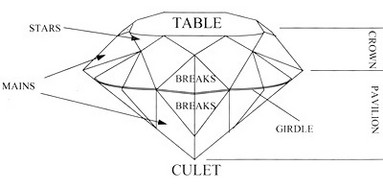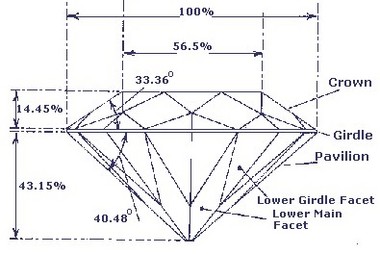| Australian Facetors' Guild Limited |
Beginners Section |
The art of gem cutting encompasses a wide field of endeavour. Some gems may be produced with very little effort; others may require many hours of tedious work. The cutting of faceted gems is an exacting procedure. The good facet cutter is concerned with the precise placement, shape, size, and polishing of the facets that completely surround what is known as a faceted gem. Some characteristics of gemstones that need to be considered by the facetor are clarity, hardness, cleavage and fracture.
Clarity Speaks for itself. If gem material is not transparent then it is not suitable for faceting. Hardness Affects the approach that will be taken to cutting and more particularly to polishing. Gemstones are graded in hardness using the Moh's scale of 1 to 10, 10 being the hardest. It is fortunate that there are a fairly large number of gems with a hardness range from 7 to 8 and it is from this group that the average facetor chooses most material. Topaz has a harness of 8, Quartz, 7 and Corundum 9. Is the tendency of a mineral to split along a straight line producing a flat surface. Topaz has perfect cleavage in one direction. Fracture All gem material will fracture under stress. This includes heat stress in some types of gemstone. Critical Angle A factor, which has an influence on the reflections and refraction of the finished gem, is what is known as the critical angle. The term critical angle means exactly that. It is the critical point below which no light ray will be reflected within the stone. If the pavilion facets are cut below the critical angle light entering the stone through the table will not be returned through the crown but will be lost through the bottom of the pavilion. The resultant stone is termed a "fish eye" and this term aptly describes the effect. | The Facet Machine Cutting of the facets is actually a grinding operation and is carried out on a series of flat laps on the facet machine. These laps range from coarse laps of 100 grit used for roughing out and preforming the stone, 360 grit lap for cutting the main facets, 1200 grit for pre polishing and cutting the smaller facets. Finer grit laps of 3000 and 14000 grit are used for pre polishing harder stones. Polishing of gems is a skill that only comes with practice. Good eyesight is essential if a good polish is to be obtained.
|
Terms
|
|


